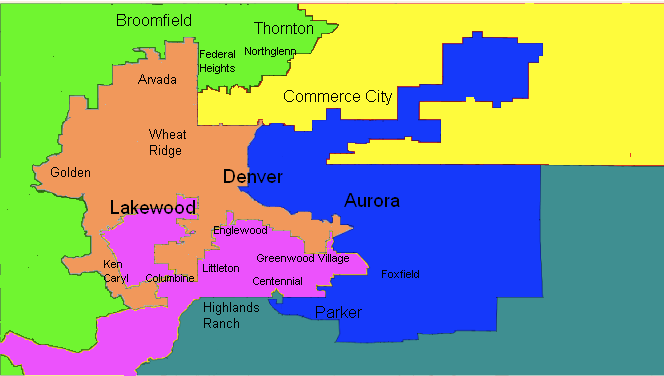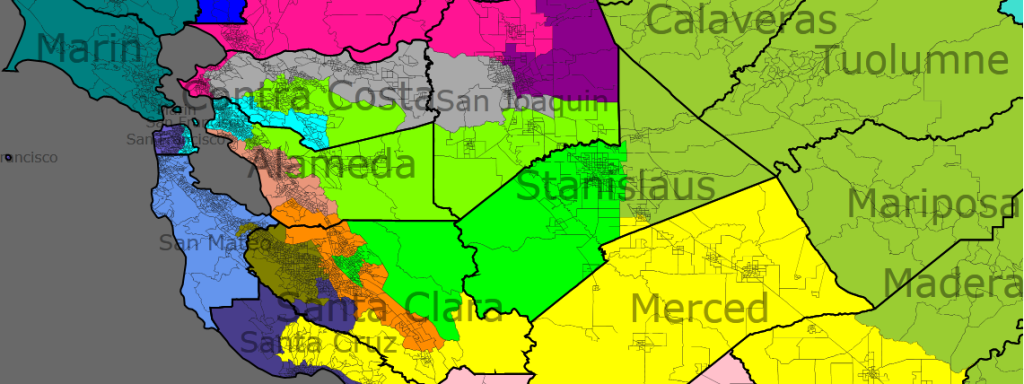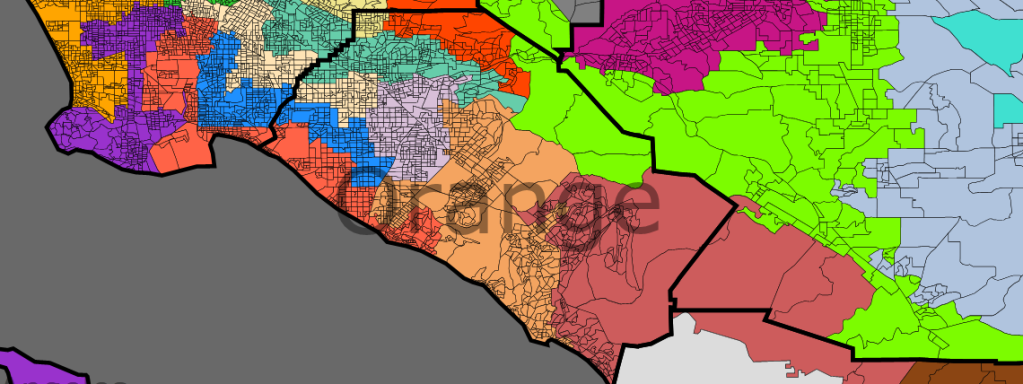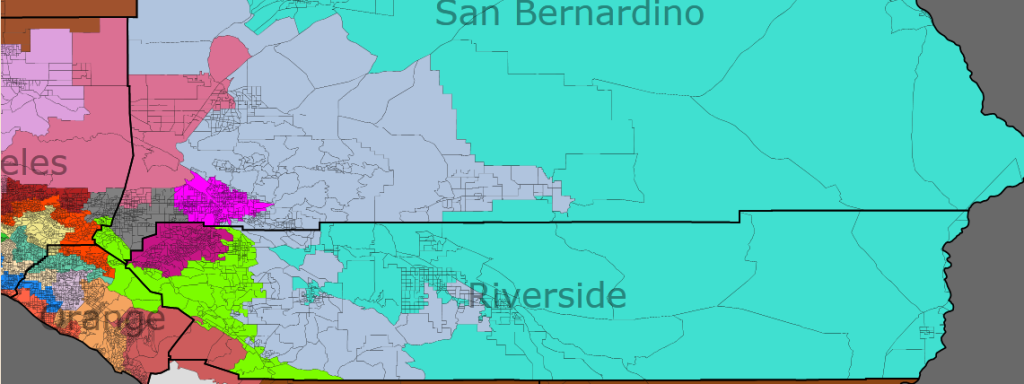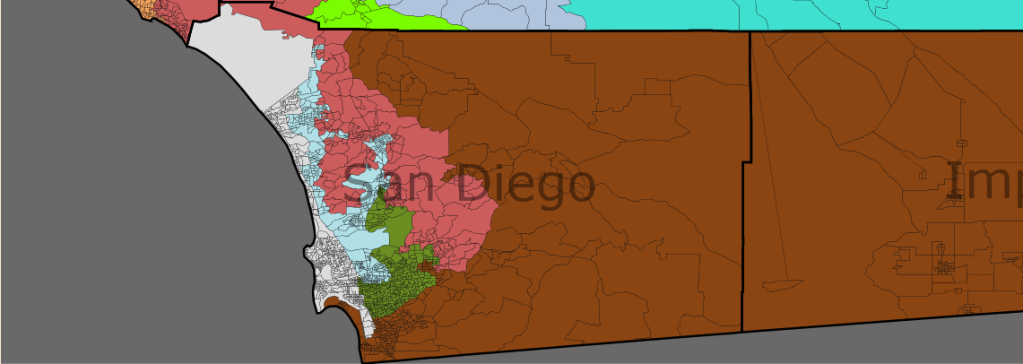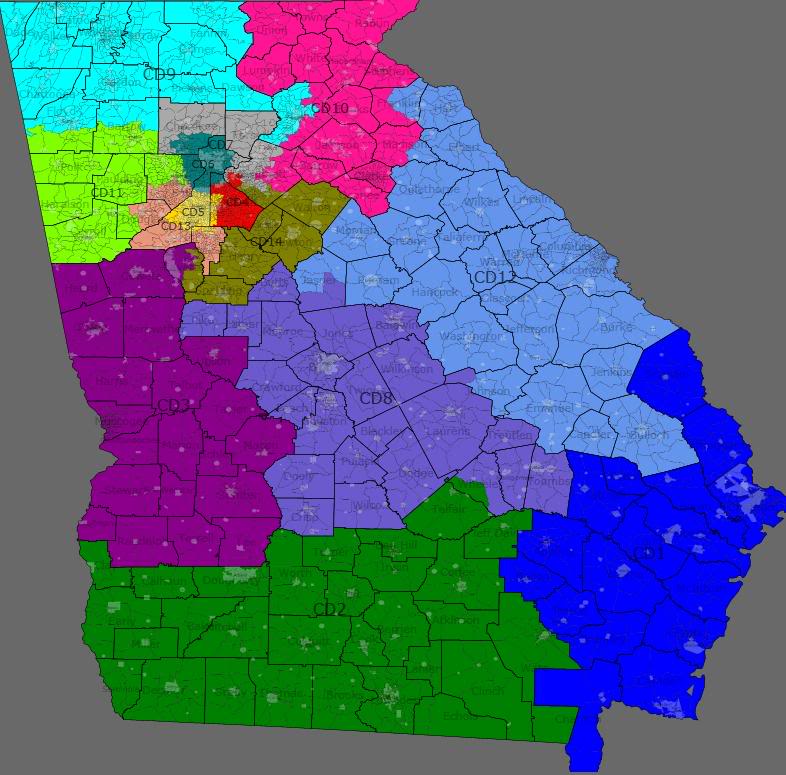(Cross-posted on Calitics and the Daily Kos)
Back in August I posted a diary here re. redistricting California:
http://www.swingstateproject.c…
Since that time, Dave’s Redistricting Application has become available for the state. The Application is an invaluable tool in doing these maps. It has helped me greatly in trying to come up with a new, better version of a plan for the state. I have also taken reader comments from my last diary into consideration in drawing this new plan for California. The comments have helped me greatly in terms of refining the districts here. As several readers rightfully noted, several of the districts I drew last time were not Democratic enough to assure that they would be virtually guaranteed to elect Democrats, and parts of the previous map were too gerrymandered. Here’s my new version …
Like last time, I had several main goals in mind when redistricting California:
1. Increase Democratic representation in the state delegation.
2. Draw relatively compact districts that largely adhere to county and community lines.
3. Increase number of minority-majority districts in the state.
4. Protect incumbents (at least the Democratic ones). Towards this goal, I have added a “measuring stick” of sorts to the analysis below. For each district I provide a “TTP” number (Territory Transfer Percentage – for lack of a better label !) which does nothing more than provide the percentage of the new district’s territory (in terms of population) that was formerly a part of the current district (the Application makes this really easy.) So, for example, in CA-7, the “TTP” is 79. The proposed district contains much of the same territory as the current district, and 79% of the new district’s population was formerly a part of the old district; in other words, George Miller would be looking at a district where 79% of his new constituents are the same as his old constituents.
Under this plan, 35 districts are created where Obama had at least 62% of the vote and McCain had at most 36%. Another 6 districts are ones which are 61-37, 61-38 or 60-38 Obama-McCain. (All 41 of the districts mentioned went for John Kerry in 2004; including 34 where Bush had 45% of the vote or less in 2004.) 1 district was won by Obama 52-46. The remaining 11 districts were all won by McCain (and in all 11 districts Bush received 60% or more of the vote in 2004).
In a “neutral” political climate, this plan should result in a net gain of 7 seats for the Democrats (Districts 3, 24, 25, 26, 45, 46, 50). One additional seat, District 48, might prove to be competitive in the future. Additionally, this map strengthens several Democratic-held districts, most notably District 11.
Under the new map, 4 new Hispanic-majority seats are created (Districts 16, 25, 26, 46) although it’s really only a net gain of 3 as CA-32 is turned from majority Hispanic to plurality Asian. Additionally, the new CA-45 becomes 49% Hispanic and may become Hispanic-majority in the future, although in many parts of California, a district needs to be around 60% or more Hispanic to ensure representation. All-in-all, 21 of 53 districts under the new plan are either Hispanic majority or plurality (including several GOP seats, where many Hispanics are still unregistered or are ineligible because they are non-citizens). Several existing Hispanic-majority seats (most notably CA-28 and CA-51) become even more Hispanic, where the incumbents there may face a challenge in the Democratic primary.
Districts 15 and 32 become plurality Asian districts. (Btw, the demographic stats below include percentages for groups that total 10% or more of the population of a particular district).
MAPS:







District 1:
Incumbent: Mike Thompson
Current District: Obama 66; McCain 32
Proposed District: Obama 64; McCain 34 (Kerry 58; Bush 41)
Demographics: white 68; hispanic 21
TTP: 34
This district combines parts of the current CA-1 (Napa and Lake Counties and parts of Sonoma Co. — Sonoma, Healdsburg) with added parts of Sonoma Co. (Santa Rosa, Rohnert Park, Cotati, Sebastopol), and parts of the central valley (including Chico and most of Butte Co.). The new district is a bit less Democratic than the current one, but should still be very safe for blue dog Thompson (though he’s really not as conservative as other blue dogs). Even though only about 34% of the new district’s territory is currently part of CA-1, another 35% is taken out of areas in Sonoma Co. currently in CA-6 which are even more progressive. The remainder is in the central valley, but Thompson’s involvement with agricultural issues should be an added bonus in the rural areas of the district.
District 2:
Incumbent: Wally Herger
Current District: Obama 43; McCain 55
Proposed District: Obama 39; McCain 59 (Kerry 33; Bush 66)
Demographics: white 72; hispanic 16
TTP: 69
Combines the most Republican parts of northern California into one district – all of Siskiyou, Modoc, Lassen, Shasta, Tehama, Plumas, Sierra, Yuba and Sutter Counties, as well as most of Colusa, small parts of Butte, and some of the most Republican parts of Placer. District becomes even more Republican than the current CA-2.
District 3:
Incumbent: Dan Lungren
Current District: Obama 49; McCain 49
Proposed District: Obama 61; McCain 37 (Kerry 52; Bush 47)
Demographics: white 42; hispanic 23; asian 18; black 10
TTP: 17
The new district combines all of progressive Yolo County with purple to blue-leaning parts of Sacramento Co.; the district stays in the same general area but over 80% of the territory here is new. A Democrat should do well running here. In 2008 Lungren only won the current CA-3 by a 49.5 to 44 margin. Democratic Gain !
District 4:
Incumbent: Tom McClintock
Current District: Obama 44; McCain 54
Proposed District: Obama 45; McCain 53 (Kerry 39; Bush 60)
Demographics: white 80; hispanic 11
TTP: 75
The new CA-4 includes all of Nevada, El Dorado, Amador, Calaveras, Alpine and Mono Counties, as well as parts of Placer and Sacramento Counties. Charlie Brown might have won last year by a sliver under the new lines (he only lost to McClintock by 0.5 point) but the new district is nevertheless a Republican one.
District 5:
Incumbent: Doris Matsui
Current District: Obama 70; McCain 28
Proposed District: Obama 64; McCain 34 (Kerry 55; Bush 44)
Demographics: white 57; hispanic 19; asian 10
TTP: 55
The new district combines most of the city of Sacramento with GOP-leaning suburbs in Sacramento Co. The Democratic percentage goes down around 6 points, but the district remains safely Democratic.
District 6:
Incumbent: Lynn Woolsey
Current District: Obama 76; McCain 22
Proposed District: Obama 72; McCain 26 (Kerry 66; Bush 33)
Demographics: white 74; hispanic 15
TTP: 58
The new CA-6 includes Woolsey’s current territory — all of Marin and parts of Sonoma Counties. Additional parts of the north coast are attached — all of Del Norte, Humboldt, Mendocino and Trinity Counties, as well as a part of northern Sonoma around Cloverdale. The Democratic margin goes down a bit, but the progressive Woolsey should feel right at home in her new 72% Obama district that stretches along the entire length of the north coast from the Golden Gate to the Oregon border.
District 7:
Incumbent: George Miller
Current District: Obama 72; McCain 27
Proposed District: Obama 66; McCain 33 (Kerry 61; Bush 38)
Demographics: white 43; hispanic 23; asian 15; black 12
TTP: 79
The boundaries of the new CA-7 adhere pretty closely to those of the current district. The lines include most of Solano County as well as parts of Contra Costa Co. — Martinez, Pinole, Hercules, San Pablo, Clayton and part of Concord. The Democratic percentage goes down by about 6 points, as the district loses Richmond and expands more into Solano, but the district remains solidly Democratic.
District 8:
Incumbent: Nancy Pelosi
Current District: Obama 85; McCain 12
Proposed District: Obama 85; McCain 13 (Kerry 85; Bush 14)
Demographics: white 44; asian 30; hispanic 15
TTP: 96
The San Francisco based CA-8 changes ever so slightly, as areas in the Sunset district are added to maintain equal population.
District 9:
Incumbent: Barbara Lee
Current District: Obama 88; McCain 10
Proposed District: Obama 76; McCain 22 (Kerry 73; Bush 25)
Demographics: white 43; hispanic 20; black 17; asian 15
TTP: 56
Combines ultra-progressive areas in Oakland, Berkeley, Albany and Emeryville with more conservative (relatively speaking) areas in Contra Costa County (Moraga, Orinda, Lafayette, Walnut Creek, Danville, San Ramon, Brentwood), as well as Livermore in eastern Alameda Co. Most African-American areas in Oakland remain in CA-9, even though other parts of Oakland are lost to the new CA-11. The Democratic percentage goes down a lot, but as it started at 88% Obama, it can afford to fall a lot and still leave this a very solidly Democratic district.
District 10:
Incumbent: John Garamendi
Current District: Obama 65; McCain 33
Proposed District: Obama 66; McCain 32 (Kerry 60; Bush 39)
Demographics: white 48; hispanic 26; asian 11; black 10
TTP: 51
The new district is largely similar to the current one. Like the current district, it includes communities in Contra Costa, Solano and Sacramento Counties (some, such as Richmond in Contra Costa, have been added). Livermore in Alameda Co. is taken out and is substituted by the addition of Lodi in San Joaquin Co. Overall, the Democratic percentage goes up slightly.
District 11:
Incumbent: Jerry McNerney
Current District: Obama 54; McCain 44
Proposed District: Obama 61; McCain 37 (Kerry 52; Bush 47)
Demographics: white 57; hispanic 21; asian 11
TTP: 34
Much of the district remains the same. Some light-blue to purple areas in Contra Costa, San Joaquin and Santa Clara Counties are detached while the district expands into parts of Oakland (blue as can be) and Stanislaus Co (purple). The expansion into Oakland alone makes the Democratic percentage go up enough to make this a safer Democratic district. Even though only about 34% of the new district’s territory is currently part of CA-11, another 31% comes out of Oakland and other progressive areas currently in CA-9 (the expansion into Oakland doesn’t hurt CA-9 at all).
District 12:
Incumbent: Jackie Speier
Current District: Obama 74; McCain 24
Proposed District: Obama 74; McCain 24 (Kerry 72; Bush 27)
Demographics: white 44; asian 30; hispanic 20
TTP: 91
The new district remains very similar to the current one. Boundaries in San Francisco shift a bit, while in San Mateo Co., a part of Redwood City is added, so that now all of it is in CA-12.
District 13:
Incumbent: Pete Stark
Current District: Obama 74; McCain 24
Proposed District: Obama 74; McCain 24 (Kerry 71; Bush 28)
Demographics: asian 33; white 32; hispanic 24
TTP: 94
The new district is very similar to the current one. It includes Fremont, Newark, Union City, Hayward, San Leandro and Alameda, and remains plurality Asian.
District 14:
Incumbent: Anna Eshoo
Current District: Obama 73; McCain 25
Proposed District: Obama 72; McCain 26 (Kerry 67; Bush 31)
Demographics: white 59; asian 19; hispanic 15
TTP: 59
This is another Bay Area district that stays demographically similar to the current seat under this plan. The district continues to closely overlap with Silicon Valley; it loses parts of Sunnyvale to the new CA-15 and Santa Cruz Co. areas to CA-17, but expands into new territory in Santa Clara Co. (Campbell, Los Gatos and parts of San Jose).
District 15:
Incumbent: Mike Honda
Current District: Obama 68; McCain 30
Proposed District: Obama 68; McCain 30 (Kerry 63; Bush 36)
Demographics: asian 43; white 33; hispanic 18
TTP: 63
New district is centered on San Jose; though the boundaries change somewhat. The district becomes plurality Asian, though it should be noted that the “Asian” population here includes persons from East Asia, South Asia and parts of the Middle East.
District 16:
Incumbent: Zoe Lofgren
Current District: Obama 70; McCain 29
Proposed District: Obama 63; McCain 35 (Kerry 57; Bush 42)
Demographics: hispanic 51; white 25; asian 18
TTP: 58
The new CA-16 combines the San Jose core of the current district with more conservative areas in the central valley. The Democratic percentage goes down somewhat, but it remains a safely Democratic seat. The district becomes majority Hispanic, but only by a bare majority. Lofgren should have no trouble winning here as long as she wants to run, but if she decides to retire the seat may elect a Hispanic representative.
District 17:
Incumbent: Sam Farr
Current District: Obama 72; McCain 26
Proposed District: Obama 63; McCain 35 (Kerry 57; Bush 42)
Demographics: white 62; hispanic 26
TTP: 50
The new district includes all of Santa Cruz County, coastal areas of Monterey County, interior areas of San Luis Obispo and Santa Barbara Counties, as well as portions of southern Santa Clara County (Morgan Hill and parts of San Jose). It remains safely Democratic.
District 18:
Incumbent: Dennis Cardoza
Current District: Obama 59; McCain 39
Proposed District: Obama 60; McCain 38 (Kerry 50; Bush 49)
Demographics: hispanic 44; white 30; asian 14
TTP: 68
CA-18 remains similar to the current district in many respects, though it doesn’t look quite the same on a map. Stockton and other areas in San Joaquin Co., parts of Modesto, and areas in Merced Co., which is Cardoza’s home area, form much of the district. It remains plurality Hispanic. The partisan breakdown inches up in the Democrat’s direction. Blue dog Cardoza should have no trouble winning here.
District 19:
Incumbent: George Radanovich
Current District: Obama 46; McCain 52
Proposed District: Obama 41; McCain 57 (Kerry 34; Bush 65)
Demographics: white 56; hispanic 33
TTP: 39
The new district becomes more Republican than the current one, as areas in Fresno County are shifted around; the goal is to make the neighboring CA-20 a bit more Democratic, as well as create a new Hispanic-majority, Democratic district next door (the new CA-25). The new 19th includes all of Tuolumne and Mariposa Counties, most of Madera Co., and parts of Fresno, Kings and Tulare Counties.
District 20:
Incumbent: Jim Costa
Current District: Obama 60; McCain 39
Proposed District: Obama 61; McCain 37 (Kerry 52; Bush 47)
Demographics: hispanic 69; white 16
TTP: 98
The district remains very similar to the current one, with a few areas shifted around to make it marginally more Democratic. The district continues to include parts of the cities of Fresno and Bakersfield, as well as more rural areas in between. (My “TTP” here, 98, may seem off, as the district doesn’t look exactly like the old one. Some populated areas in northern Kings Co. have indeed been taken out, but as the TTP is a measure of what percentage of the NEW district was formerly a part of the old, any areas taken OUT would have no effect on the measure as they are no longer a part of the NEW district.)
District 21:
Incumbent: Devin Nunes
Current District: Obama 42; McCain 56
Proposed District: Obama 47; McCain 51 (Kerry 37; Bush 62)
Demographics: hispanic 45; white 41
TTP: 40
The new district continues to include much of Tulare County, but also expands into new territory — parts of what is currently CA-25 (Inyo Co. and western portions of San Bernardino Co.). The new partisan numbers may appear competitive (and the district is plurality Hispanic), but it should be noted that the new district had one of the highest Democratic jumps between 2004 and 2008 (and much of the Hispanic population here is undocumented or unregistered). Fundamentally, this still remains a very Republican district; the future may hold a different scenario (?).
District 22:
Incumbent: Kevin McCarthy
Current District: Obama 38; McCain 60
Proposed District: Obama 38; McCain 60 (Kerry 30; Bush 69)
Demographics: white 57; hispanic 28
TTP: 83
In most ways, the new CA-22 remains geographically and politically similar to the current district. The San Luis Obispo Co. interior areas are detached. The new CA-22 is politically the most conservative in California.
District 23:
Incumbent: Lois Capps
Current District: Obama 66; McCain 32
Proposed District: Obama 66; McCain 32 (Kerry 58; Bush 40)
Demographics: hispanic 46; white 44
TTP: 98
The new district is almost identical to the current one, following the coast from Oxnard through Santa Barbara and San Luis Obispo Counties.
District 24:
Incumbent: Elton Gallegly
Current District: Obama 51; McCain 48
Proposed District: Obama 62; McCain 36 (Kerry 55; Bush 44)
Demographics: white 68; hispanic 19
TTP: 56
The new district combines much of Ventura Co. with parts of Los Angeles Co. (Malibu, Santa Monica, Calabassas, Hidden Hills, Agoura Hills, Westlake Village and parts of the city of Los Angeles). The new lines and partisan numbers don’t look great for Gallegly. He won with 58% last year against token opposition in a district that is much more Republican and his Simi Valley home is cut out of the district under this plan. It should also be noted that Gallegly almost retired in 2006. This all leads to a likely Democratic Gain !
District 25:
Incumbent: none (district completely relocated)
Current District: Obama 49; McCain 48 (but not really applicable as district relocated from southern California where it is a GOP district)
Proposed District: Obama 61; McCain 38 (Kerry 51; Bush 47)
Demographics: hispanic 60; white 27
TTP: 0
CA-25 is a new Hispanic-majority district (at 60% of the population) encompassing much of interior Monterey County (including Salinas), all of San Benito Co. and areas of Madera, Fresno and Santa Clara Counties. This is a major agricultural area; it is designed to elect a Hispanic-American Democratic Rep. Democratic Gain !
District 26:
Incumbent: David Dreier
Current District: Obama 51; McCain 47
Proposed District: Obama 63; McCain 35 (Kerry 56; Bush 43)
Demographics: hispanic 61; white 22; asian 12
TTP: 18
This new district encompasses only a few of the areas currently in CA-26 — San Dimas, La Verne and Claremont. It also includes El Monte, South El Monte, Irwindale, Baldwin Park, La Puente, Covina, West Covina and Azusa. The district becomes Hispanic majority, and a solid majority one at that. Last year Dreier had 53% to 40% for the Democrat and 7% for a Libertarian candidate. Good luck to Dreier if he seeks re-election here. Very likely, a Democratic Gain !
District 27:
Incumbents: Brad Sherman; Howard McKeon
Current District: Obama 66; McCain 32 (Obama 49-McCain 48 in McKeon’s CA-25, which is relocated to central California)
Proposed District: Obama 64; McCain 34 (Kerry 57; Bush 41)
Demographics: white 52; hispanic 31
TTP: 33
The bulk of this district is made up of communities within the city of Los Angeles (North Hollywood, San Fernando valley neighborhoods, etc.). Also attached is Santa Clarita to the north. The new district is safely Democratic. Even though only about 33% of the new district’s territory is currently part of CA-27, another 42% comes out of what is now CA-28, which is an even more progressive area. The remainder is Santa Clarita and vicinity (McKeon’s CA-25).
District 28:
Incumbent: Howard Berman
Current District: Obama 76; McCain 22
Proposed District: Obama 66; McCain 32 (Kerry 59; Bush 40)
Demographics: hispanic 64; white 22
TTP: 52
This district becomes even more Hispanic than the current version. The new lines include a good part of the San Fernando Valley as well as Palmdale in northern LA County. The district becomes less Democratic, but the only upset here could occur in the Democratic primary if a Hispanic-American candidate makes a run for the seat. Perhaps Berman would decide to run in a primary against Brad Sherman under this map, as over 40% of Sherman’s new district includes territory currently a part of CA-28.
District 29:
Incumbent: Adam Schiff
Current District: Obama 68; McCain 30
Proposed District: Obama 63; McCain 35 (Kerry 56; Bush 42)
Demographics: white 49; hispanic 25; asian 15
TTP: 61
The new CA-29 includes most of Schiff’s current territory in Pasadena, Glendale and Burbank. Areas to the east are added (Sierra Madre, Arcadia, Monrovia, Bradbury, Glendora, La Canada-Flintridge) — mostly from the current CA-26. The Democratic margin goes down somewhat, but this is still a safely Democratic seat.
District 30:
Incumbent: Henry Waxman
Current District: Obama 70; McCain 28
Proposed District: Obama 65; McCain 33 (Kerry 60; Bush 39)
Demographics: white 63; hispanic 20; asian 10
TTP: 46
This westside LA district includes communities currently in CA-30 (Beverly Hills, West Hollywood and various parts of Los Angeles) as well as newly attached areas in Los Angeles (San Fernando Valley) and in Ventura Co. (Simi Valley, Moorpark). Santa Monica, Malibu and a few other areas are taken out and attached to the neighboring CA-24. The district remains a Democratic bastion, and a quite progressive one at that (and yes, the Reagan Library and West Hollywood are now in the same district !)
District 31:
Incumbent: Xavier Beccera
Current District: Obama 80; McCain 18
Proposed District: Obama 80; McCain 18 (Kerry 77; Bush 22)
Demographics: hispanic 64; white 15; asian 14
TTP: 76
This central Los Angeles district shifts westward a bit, but for the most part (including partisan demographics) remains as is.
District 32:
Incumbent: Judy Chu
Current District: Obama 68; McCain 30
Proposed District: Obama 62; McCain 36 (Kerry 56; Bush 43)
Demographics: asian 42; hispanic 37; white 16
TTP: 28
The new CA-32 runs from a part of East Los Angeles through Monterey Park, Alhambra, South Pasadena, San Marino, Temple City, San Gabriel, Rosemead, Walnut, Diamond Bar and areas in between. The district becomes plurality Asian. Many Hispanic-majority areas of the current CA-32 are detached in order to create the new Hispanic-majority CA-26 just to the north and east of the new CA-32.
District 33:
Incumbent: Diane Watson
Current District: Obama 87; McCain 12
Proposed District: Obama 88; McCain 11 (Kerry 84; Bush 15)
Demographics: hispanic 46; black 29; white 12
TTP: 70
The new CA-33 expands somewhat into south central LA to keep the black percentage as high as possible here, although as south central is rapidly becoming majority Hispanic, the resulting district is only 29% black. Also added is the Westchester area around LAX., while the Silver Lake/Griffith Park area is taken out of the district.
District 34:
Incumbent: Lucille Roybal-Allard
Current District: Obama 75; McCain 23
Proposed District: Obama 76; McCain 22 (Kerry 70; Bush 29)
Demographics: hispanic 77; white 10
TTP: 76
The new district is very similar to the current one, including downtown Los Angeles, Downey, and everything in between, as well as new territory north of downtown. Bellflower is detached from the district.
District 35:
Incumbent: Maxine Waters
Current District: Obama 84; McCain 14
Proposed District: Obama 73; McCain 25 (Kerry 68; Bush 31)
Demographics: hispanic 45; black 28; white 15
TTP: 36
There’s only one way the new district here could have been drawn ! Yes … the heart of south central LA/Watts and Inglewood are combined with the Palos Verdes peninsula. Also included are Carson, the Wilmington and San Pedro areas of LA, and Avalon on Santa Catalina Island. Even though only about 36% of the new district’s territory is currently part of CA-35, another 26% is taken out of areas currently in the districts of African-American Representatives Diane Watson and Laura Richardson. The Democratic percentage falls by over 10 points, but Waters should still be very safe in the resulting 73% Obama district.
District 36:
Incumbent: Jane Harman
Current District: Obama 64; McCain 34
Proposed District: Obama 64; McCain 34 (Kerry 59; Bush 40)
Demographics: white 42; hispanic 30; asian 17
TTP: 69
The new CA-36 is similar to the current district hugging Santa Monica Bay. Some communities are detached (Wilmington and San Pedro areas of LA.) while others are attached (Hawthorne, Lawndale, Gardena), but the partisan demographics remain the same.
District 37:
Incumbents: Laura Richardson; Dana Rohrabacher
Current District: Obama 80; McCain 19 (Obama 48-McCain 50 in Rohrabacher’s CA-46, which is relocated to the inland empire area)
Proposed District: Obama 65; McCain 33 (Kerry 59; Bush 39)
Demographics: hispanic 38; white 33; black 14; asian 11
TTP: 67
The new district includes most of Long Beach and Huntington Beach, as well as all of Seal Beach and Compton. About 67% of the new district’s territory comes out of the current CA-37, while about 33% comes out of the current CA-46. I know that Richardson is not the best California Democratic Rep, but even she should be safe in this seat (any semi-competent Democrat should be OK here.) Ideally, a better Democrat wins here in a primary. In the meantime, Rohrabacher can go back to concentrate on his surfing.
District 38:
Incumbent: Grace Napolitano
Current District: Obama 71; McCain 27
Proposed District: Obama 63; McCain 35 (Kerry 57; Bush 42)
Demographics: hispanic 65; white 22
TTP: 47
This remains a majority-Hispanic district encompassing areas like Norwalk, Bellflower, Artesia, Santa Fe Springs, Pico Rivera, Montebello, Whittier and a part of East LA — all in Los Angeles County, as well as La Habra and parts of Fullerton and Placentia in Orange County. Even though only 47% of the new district’s territory comes out of the current CA-38, another 28% comes out of neighboring Democratic-held seats, CA-34 and CA-39; the remaining 25% comes out of currently GOP-held seats.
District 39:
Incumbent: Linda Sánchez
Current District: Obama 65; McCain 32
Proposed District: Obama 66; McCain 32 (Kerry 59; Bush 40)
Demographics: hispanic 61; white 20; asian 10
TTP: 82
The new district is very similar to the current one, including parts of LA County — South Gate, Lynwood, Paramount, Lakewood, Hawaiian Gardens, Cerritos, La Mirada and a part of Long Beach.
District 40:
Incumbent: Ed Royce
Current District: Obama 47; McCain 51
Proposed District: Obama 46; McCain 52 (Kerry 38; Bush 61)
Demographics: white 45; asian 26; hispanic 23
TTP: 57
The Orange Co.-based district is somewhat similar to the current one, but becomes slightly more Republican, as communities are shifted around. Placentia, Orange, Villa Park and a part of Fullerton are detached, while Fountain Valley, Newport Beach and parts of Westminster, Huntington Beach and Garden Grove are added.
District 41:
Incumbent: Jerry Lewis
Current District: Obama 44; McCain 54
Proposed District: Obama 44; McCain 54 (Kerry 37; Bush 62)
Demographics: white 59; hispanic 29
TTP: 69
This district includes much of central and eastern San Bernardino County, as well as parts of Riverside Co. (Banning, Beaumont, Calimesa, Rancho Mirage, Palm Desert, Indian Wells, La Quinta and Blythe.)
District 42:
Incumbent: Gary Miller
Current District: Obama 45; McCain 53
Proposed District: Obama 42; McCain 56 (Kerry 34; Bush 65)
Demographics: white 60; hispanic 22; asian 12
TTP: 56
This is the “stereotypical” Orange County of Richard Nixon. The district runs from his birthplace in Yorba Linda to his “summer White House” in San Clemente. Also included are Brea, Orange, Villa Park, Mission Viejo, Rancho Santa Margarita, parts of Placentia, Anaheim and San Juan Capistrano, as well as the Chino Hills part of San Bernardino Co. The new district becomes even more Republican than the current one.
District 43:
Incumbent: Joe Baca
Current District: Obama 68; McCain 30
Proposed District: Obama 66; McCain 32 (Kerry 56; Bush 43)
Demographics: hispanic 60; white 20; black 12
TTP: 82
The new CA-43 inlcudes many of the same areas as the current district — the city of San Bernardino, Colton, Rialto and Fontana — as well as added areas, parts of Redlands and Highland. The new district remains majority-Hispanic.
District 44:
Incumbent: Ken Calvert
Current District: Obama 50; McCain 49
Proposed District: Obama 46; McCain 52 (Kerry 36; Bush 62)
Demographics: white 52; hispanic 34
TTP: 56
The new CA-44 is completely confined to Riverside County, and includes communities like Corona, Norco, Lake Elsinore, Canyon Lake and Hemet. I’ve made the adjoining CA-45 much more Democratic, so this district has to become more Republican to balance the numbers. I hate to leave Calvert in place, but the way the new CA-45 looks, it’s quite likely that Mary Bono could choose to run here instead. In fact, she already represents almost a quarter of the new district’s population, and it would make more sense for her to run here and challenge the ethically-challenged Calvert in a primary, rather than run in the much more Democratic new CA-45 next door.
District 45:
Incumbent: Mary Bono Mack
Current District: Obama 52; McCain 47
Proposed District: Obama 62; McCain 36 (Kerry 53; Bush 45)
Demographics: hispanic 49; white 31; black 10
TTP: 42
The new lines here maintain the district wholly within Riverside County. Only the most Democratic areas are included – including Moreno Valley, Perris, Cathedral City, Palm Springs and much of Riverside. Bono Mack lives in Palm Springs, and she won last time with 58% of the vote against a weak opponent. It would make much more sense for her to run in CA-44 next door, or even in the new CA-41 which now expands into Riverside Co. areas just east of Palm Springs. Both CA-41 and CA-44 GOP incumbents are ethically challenged and Bono currently represents good parts of those districts. She would have a very hard to win race here. If a credible Democrat runs in this 53 Kerry-45 Bush district, it is likely to be a Democratic Gain !
District 46:
Incumbent: none (district completely relocated)
Current District: Obama 48; McCain 50 (but not really applicable as district relocated from coastal Orange and LA Counties where it is a GOP district)
Proposed District: Obama 64; McCain 34 (Kerry 54; Bush 45)
Demographics: hispanic 64; white 22
TTP: 0
California’s “Inland Empire” has had some of the state’s highest growth rate of the last decade, fueled largely by an increase in the Hispanic population. The new CA-46 reflects that growth through the creation of a new Hispanic-majority district here. The new district includes the unincorporated extreme northwestern part of Riverside County as well as areas in San Bernardino Co. (Ontario, Montclair, Chino and parts of Rancho Cucamonga and Fontana), as well as most of Pomona in LA County. Democratic Gain !
District 47:
Incumbent: Loretta Sanchez
Current District: Obama 60; McCain 38
Proposed District: Obama 61; McCain 37 (Kerry 50; Bush 49)
Demographics: hispanic 68; white 15; asian 13
TTP: 97
The new CA-47 is very similar to the current district. A few more Democratic precincts in Santa Ana are added, while more GOP parts of Garden Grove are detached, making the new district a tad more Democratic. Parts of Anaheim and Fullerton are also in the district. The Asian percentage goes down by a few points, as some of the Garden Grove areas are detached.
District 48:
Incumbent: John Campbell
Current District: Obama 49; McCain 49
Proposed District: Obama 52; McCain 46 (Kerry 43; Bush 56)
Demographics: white 57; hispanic 21; asian 16
TTP: 78
The major change here is that Republican Newport Beach and North Tustin/Tustin Foothills are detached, while Democratic Costa Mesa is attached. Irvine, Aliso Viejo, Dana Point, Laguna Beach, Laguna Niguel, Laguna Woods, Laguna Hills, Tustin and Lake Forest remain in the district. The Democratic numbers go up, but probably not enough to initially make a dramatic difference. However, with changing demographics and the right candidate we may be able to flip this seat in the future. Coastal areas in California are becoming more and more Democratic over time. This district is one that is already not very conservative on social issues (a majority here voted against Proposition 4 last year — a measure advocating parental notification before a minor’s abortion, and the electorate just barely voted yes on Prop. 8 — as opposed to other GOP areas in California where Prop. 8 had big majorities). A hard-core conservative (ie., “birther” John Campbell) may not be able to hold such a district forever.
District 49:
Incumbent: Darrell Issa
Current District: Obama 45; McCain 53
Proposed District: Obama 49; McCain 50 (Kerry 39; Bush 60)
Demographics: white 55; hispanic 31
TTP: 41
The new CA-49 includes parts of San Diego County — Oceanside, Carlsbad, Vista, San Marcos, Escondido, Rancho Santa Fe and parts of the city of San Diego (areas like Rancho Penasquitos and Rancho Bernardo). Only 41% of the new district is territory that is currently in CA-49, while 51% comes out of what is now CA-50 — including Brian Bilbray’s home in Carlsbad. The creation of this district could produce an interesting GOP primary between Issa and Bilbray. The new district remains fairly Republican (despite Obama coming within less than 3,000 votes of winning it).
District 50:
Incumbent: Brian Bilbray
Current District: Obama 51; McCain 47
Proposed District: Obama 62; McCain 36 (Kerry 54; Bush 45)
Demographics: white 61; hispanic 17; asian 14
TTP: 42
CA-50 shifts southward under this plan. The new district combines much of the northern parts of the city of San Diego — including La Jolla, Clairemont, Pacific Beach, Mission Hills, Mission Valley, Serra Mesa, Hillcrest, University Heights, Normal Heights, North Park and college areas around UCSD and SDSU (a number of these neighborhoods are added from CA-53), as well as the incorporated communities of Del Mar, Solana Beach and Encinitas. The Democratic percentage goes up significantly. Bilbray (whose home is no longer in the district under the new lines) beat Nick Leibham here last year by 5 points, while in the 2006 special election, Bilbray beat Francine Busby by 4.5 points. The new CA-50 has a Democratic margin that’s many points higher than the old CA-50; you can do the math. Democratic Gain !
District 51:
Incumbent: Bob Filner
Current District: Obama 63; McCain 35
Proposed District: Obama 63; McCain 36 (Kerry 53; Bush 46)
Demographics: hispanic 69; white 17
TTP: 79
The new district remains very similar to the current one. The only major changes are that a part of San Diego as well as unincorporated communities to the north of Chula Vista are detached while Democratic parts of Riverside Co. (Coachella, Indio) are added. The district remains majority Hispanic.
District 52:
Incumbent: Duncan Hunter
Current District: Obama 45; McCain 53
Proposed District: Obama 39; McCain 59 (Kerry 32; Bush 67)
Demographics: white 68; hispanic 20
TTP: 52
This district becomes considerably more Republican as areas in and around the city of San Diego are detached while more GOP areas in northern San Diego County and southwestern Riverside Co. (Temecula, Murrieta) are added. Only a little over half of the new district’s territory comes out of the current CA-52; much of the remainder is currently a part of CA-49.
District 53:
Incumbent: Susan Davis
Current District: Obama 68; McCain 30
Proposed District: Obama 66; McCain 32 (Kerry 59; Bush 40)
Demographics: hispanic 37; white 36; asian 12; black 10
TTP: 57
The new CA-53 is anchored by the city of San Diego, with smaller communities like Imperial Beach, Coronado, Lemon Grove, La Mesa and part of El Cajon also included. The new district includes San Diego neighborhoods like Mission Beach, Mission Bay, Ocean Beach, Point Loma/Harbor, Old Town, Downtown, City Heights and now virtually all of Southeast San Diego. The district is slightly less Democratic than the current one, but remains solid for us.
So that’s my revised plan for California. I welcome comments and suggestions.


